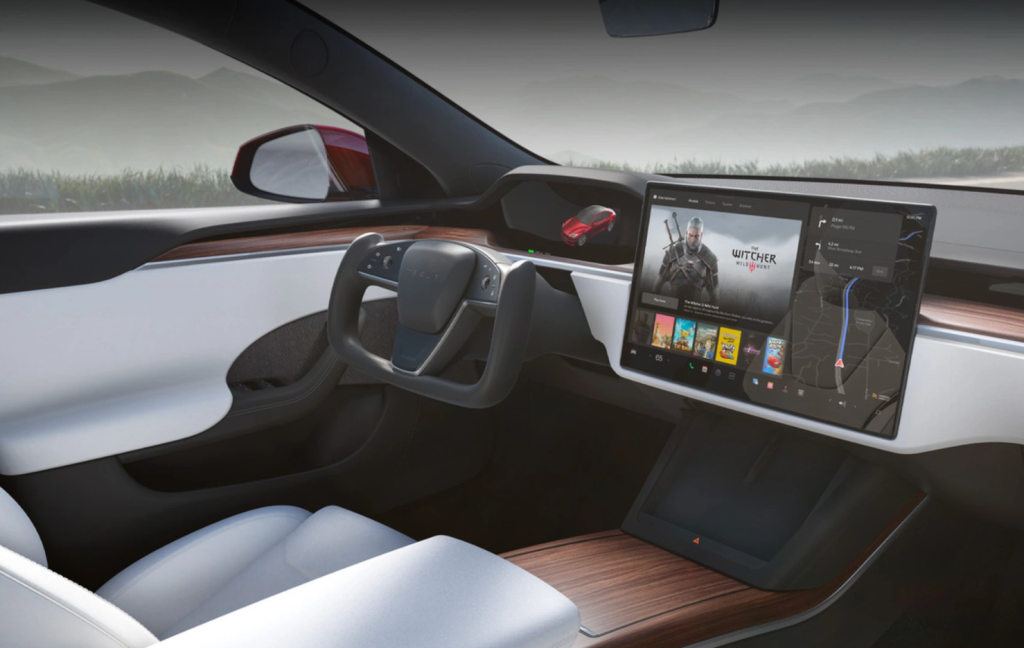Automotive Chip Surplus Fuels Gaming Showcase by Manufacturers
7 min read
In the context of today’s automotive chip performance “surplus,” manufacturers intend to showcase their capabilities through gaming.
Turning cars into game rooms is not a joke.
On June 11, 2021, during the Model S Plaid delivery event, Musk demonstrated the actual gameplay of “Cyberpunk 2077” on the car’s 17-inch infotainment screen.

(图片来自特斯拉)
It’s the era of software-defined cars, so achieving such capabilities is not surprising. However, there is a condition involved — the Model S Plaid at that time was equipped with an AMD Navi 23 GPU core, along with 8GB of GDDR6 memory, with overall performance specifications comparable to the Sony PS5.
Musk also proudly mentioned during the presentation that the Tesla Model S Plaid was the best, fastest, safest, and most sustainable vehicle, with the performance of its in-car chip equivalent to that of a Sony PS5 gaming console. In addition to “Cyberpunk 2077,” the Tesla Model S Plaid also supported running AAA games like “The Witcher 3,” effectively bringing gaming to the car.
In subsequent OTA updates for the Model S and Model X, the integrated Steam Store functionality was added. Any game that is certified for Steam Deck can be smoothly played on the in-car infotainment system.
While I haven’t personally experienced the magical gaming features on these million-dollar cars, I have also enjoyed the in-car gaming experience on Tesla’s Model Y. The gaming capabilities of the Model Y are more basic compared to the Model S/X, offering only some classic mobile games that have been ported over.

What left the most profound impression on me was the Tesla custom racing game called “Beach Buggy Racing 2” built into the Model Y. Unlike the mobile version, the in-car version allows you to control the game directly through the steering wheel, accelerator, and brakes, providing a more immersive experience than playing on a smartphone. This setup also eliminates the need to spend money on purchasing a realistic racing seat.
From an entertainment perspective, this kind of gameplay makes perfect sense, and it’s quite remarkable.
With the electric car stationary, no matter how you maneuver the vehicle in the game, it won’t affect the actual chassis. Players can enhance the immersion of racing games by utilizing the steering wheel, accelerator, and brake pedals.
While the significance might be secondary, don’t you find this incredibly cool?
Playing games in cars is no longer an unusual concept, especially with manufacturers like Tesla and an increasing number of automakers deeply integrating gaming with vehicles. While the execution might differ, the fundamental connection between gaming and cars has been established.

(Picture from Tesla)
Recently, the highly discussed N7 and N8 models from Tengshi (Li Auto) have come into the spotlight. The former comes with “Real Racing 3” pre-installed on its display car, while the latter offers a gaming package for an additional 16,800 yuan, allowing users to play mobile games using the in-car touchscreen and steering wheel. Many people might dismiss this as just a gimmick by manufacturers, but it seems that the trend of gaming scenes spreading to cars cannot be stopped.
When I saw the N7 display car equipped with “Real Racing 3,” I still felt that playing games in a car is quite advanced…
With the “excess computing power” of car infotainment chips, the need for games to showcase performance is apparent.
The question of when games “invaded” new energy vehicles is no longer significant; we only need to acknowledge that playing games in car infotainment systems is no longer a far-fetched idea.
The core chips of new energy vehicles are typically divided into infotainment system chips and auxiliary/driving chips, with the former functioning similarly to smartphone chips, determining the baseline user experience of the infotainment system.

(Picture from LOTUS NYO)
Setting aside gaming, the use cases for in-car infotainment systems mainly revolve around navigation, 360-degree observation systems, and information entertainment represented by functions like video playback and music listening. The threshold for using these functions isn’t particularly high, and the significance of high-performance chipsets in premium-grade cars is to provide quicker response times and smoother swipe experiences. Currently, whether it’s the mainstream Qualcomm Snapdragon 8155 or even the powerful AMD chipset found in the PS5, their primary use cases don’t differ significantly.
Similar to the HYPER OS cockpit operating system developed by LOTUS NYO, which is the world’s first to utilize the UNREAL engine for real-time rendering, it offers a more visually appealing and intuitive 3D modeling scene. Rendering in this context can be more complex, requiring higher hardware performance than conventional infotainment systems. This might be why the ELECTRE infotainment system requires two Qualcomm Snapdragon 8155 chips to drive it.
(Picture from LOTUS NYO)
The recently launched Lynk & Co 08, running on Flyme Auto, also incorporates real-time rendering scenes. Manufacturers have put in a lot of effort to showcase the performance of the infotainment system.
“The current infotainment chipsets are powerful, and adding games is to leverage the performance of the infotainment system,” explained a car salesperson when introducing a new car to me. While I, as a consumer, didn’t specifically consider in-car gaming, looking at it from the manufacturer’s perspective, including games to highlight the capabilities of the infotainment chipset makes sense. After all, besides gaming, there seem to be few other places where the chipset’s performance can be directly demonstrated.

By the way, AnTuTu’s benchmarking business has also extended into the automotive sector. In the future, car infotainment performance won’t only be measured through gaming, but also with more tangible benchmark scores presented to consumers. The emergence of benchmarking software has gained recognition from Qualcomm as well. They’ve launched a challenge with their latest HiPhi Y model, achieving a score as high as 756,000 points.
With the support of various Bluetooth controllers and expansion interfaces, the in-car gaming ecosystem is gradually maturing. The experience of playing games in cars isn’t much different from doing so at home. Car manufacturers also offer various ways to experience gaming. There are roughly three categories: the “console faction,” like Tesla introducing the Steam store; the “large Android gaming faction,” like BYD installing third-party software or offering optional game packages; and the “screen casting faction,” represented by companies like NIO.
On the other hand, electric cars have moved away from traditional mechanical transmission systems to electronic ones, which allows for “decoupling” between the steering wheel and the steering mechanism. This means that when you’re playing an intense racing game in a stationary electric car, the steering mechanism of the chassis won’t be affected by the rotation of the steering wheel. This addresses safety concerns arising from inadvertent movements and actually makes in-car racing gaming more reasonable.
In conclusion, the emergence of in-car gaming services isn’t without meaning. Just like modern smartphones, the upper limits of functionality in electric cars are determined by software. The hardware has already paved the way for all of this. Regardless of whether it’s deemed meaningful or not, it will be there.
Could the “in-car gaming arcade” be the future?
I don’t think that in-car gaming services are features manufacturers came up with just to create scenes. Gaming is also a part of information entertainment. The inherent advantages brought by the hardware technology of electric cars make the challenge mainly about software adaptation.
As users, apart from certain car models that can opt for these features or not at an additional cost, whether you use them or not, it doesn’t affect our overall evaluation of a vehicle. In this context of consumer preferences that want everything, it’s natural for consumers to hope that manufacturers provide a full range of features.

“Whether I use it or not is my business, and whether you have it or not is yours,” I believe this is the measuring stick in the minds of many when it comes to consumption.
The meaning that cars have bestowed upon people has long surpassed the realm of being mere transportation tools. It has given rise to greater demands for a sense of space. The present-day automotive industry is driven by user demands, and if people didn’t like certain features, why would manufacturers bother putting a “refrigerator-sized TV” in an SUV?
The concept of a “rolling living room” seems to have long been embedded in consumers’ minds. In other words, they want their cars to be their own “second home.” The rich in-car ecosystem significantly increases people’s willingness and time spent in their vehicles. Miracle, the Head of Ecosystem Services at NIO, stated that the usage rate of the co-driver’s app on the NIO ES8 surpasses 65%.

Additionally, according to official data from NIO, in 2021, NIO ONE owners spent an average of 4.4 hours per week “inside the car but not driving (parked in neutral without using battery power).” Some owners even mentioned that apart from their travel time, they spend around 5-6 hours per week in their cars, including charging and waiting for someone. Even after arriving home, they would stay in the car for 10-20 minutes.
The average time spent in the car is expected to continue increasing in the coming years. I can only imagine how much more time people might spend inside their cars if they could engage in various games.
Following the concept of a “mobile theater,” new energy vehicles might eventually earn the title of a “mobile gaming arcade.” I initially thought Tesla’s idea wasn’t realistic, but it seems my perspective was too narrow.



